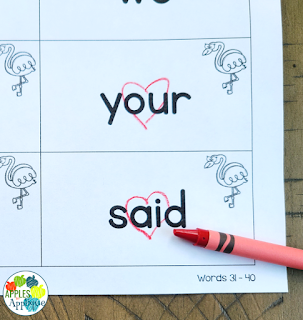I mentioned in my last post that I am taking time this summer to really delve into the science of reading, making plans to adapt my instruction this fall to better reflect what research shows about how children learn to read.
One big shift when aligning instruction with the science of reading is in the area of sight words or high frequency words. Many of us have been told that these words are not decodable and that students simply need to memorize them, leading to well-intentioned drilling with flash cards, fun activities like rainbow writing, and other strategies that are only quasi-helpful. These things work fine for higher learners, but they typically leave struggling readers floundering.
Enter heart words! This shift is based on the premise that the majority of high frequency words are, actually, largely decodable. For example, the words and, big, in and many others are completely decodable, following phonics rules without any deviation. Students can simply apply letter-sound correspondence to decode these words, which takes so much pressure off of kids trying to memorize these words in isolation.
Many other high frequency words, such as have and said, are largely decodable, as most of the letters actually follow the letter-sound rules that students have already been taught. This means that they only have to really memorize the irregular part of the word, which significantly cuts down on the memorization students have to do, and simultaneously helps them learn to rely on the letter-sound correspondence they have learned.
For example, analyzing the word said, there are 3 phonemes: /s/, /e/, /d/. The /s/ and /d/ are both easily decodable, as they are represented by the letters s and d, respectfully, just as students have been taught. That means there is only one phoneme left for students to memorize, which is the /e/. In the word said, the /e/ is represented by the letters ai; as this does not follow any phonics rule, it is marked with a heart. These letters are the ones students need to learn by heart, hence the term "heart words".
The good news is that shifting from the idea of sight words to heart words is easy! You can use whatever sight word list you are already using or is required by your district. My district uses Fry's, and I am required to keep track of how many sight words each student knows each quarter. I have an entire system I designed for use in my classroom which helps students track their own progress and facilitates communication with families. I believe it is a good system, but I knew the implementation needed updated to reflect science of reading principles.
Adapting instruction is simple! The system is already set up to send home a sheet of flash cards with students at their individual paces. Now, I will utilize small group time to have students mark the heart words on their flash cards before sending them home. I could mark the words myself before making copies, but I want the students to mark the letters themselves as we discuss it to help them cement that knowledge.
Another component of my classroom system is having students check out a class set of flash cards; on these, which are laminated, I will have students mark them with dry erase markers. Again, this will be completed during small group time so that I can oversee the process and we can analyze the phonemes and graphemes together.
I hope this inspires you to make the shift away from drilling sight words to using heart words in your classroom; it's a simple move with a big payoff for your students!
If you are interested in my whole class sight word system, which has been updated to include tips on heart words and a parent letter about heart words, you can find it here in my store or here on TPT.
Keep teaching with heart and passion!









